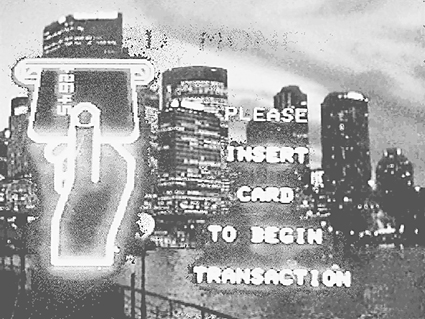Digital rules!
Michael Hill is engaged by D.art 99 at the Sydney Film Festival

Wade Marynowsky’s Diaspora 2000
D.art 99 is a gallery exhibition of CD-ROMs and a cinema screening of linear video “made by artists who use digital processes”, both programmed by dLux media arts. The screening was presented as part of the 46th Sydney Film Festival; the CD-ROMs were exhibited at Artspace from June 10 to July 3. D.art will soon tour nationally. The opening also included a performance by Wade Marynowsky and launch of the remarkable CD-ROM Basilisk & a universe of dirt by Wayne Stamp, Lloyd Sharp and Panos Couros.
We haven’t yet reached the point on the curve of increasing bandwidth that will make many of the more interesting forms of digital art easier to distribute, so opportunities to view international works locally are still rare. At D.art 99, CD-ROMs and videos from the US, England, Spain, Brazil, the Netherlands, Finland and Canada were shown alongside work from Australia. It is heartening to recognise that media artists all over the world are striving (not always successfully) to make sensible use of digital tools beyond their preset effects. dLux media arts should be commended for continuing to program international pieces—a practice first tested at D.art 98. It seems obvious that exhibiting the best international pieces benefits local production and critical practice, in much the same way that the major film festivals have offered film practitioners an international context for their efforts. Once the relevant funding organisation emerges from the Hall of Mirrors it may be encouraged to support the exhibition of international digital media art locally.
One of the highlights of the video program was Peter Callas’ work-in-progress Lost in Translation—part 1: Plus Ultra, his first piece since moving his production process out of the video studio and onto the desktop. You have to admire anyone who will learn Unix for their art, and the result of his extensive re-skilling in SoftImage is shown in this piece which seems to offer an expanded dimension to his previous efforts in the essentially 2D world of the Fairlight video synthesiser. While still using 2D sources—images and drawings from the heroic period of Portuguese exploration and consequent non-heroic period of South American colonisation—Callas has managed to manipulate them (figures especially) in a manner which suggests a life in 3 dimensions. In one sequence a Prince-Henry-the-Navigator type of figure is seen hunched over a map and continues to draw and redraw the edges of the world. In another a bed-ridden figure cut from what looks like a Goya is made to buckle in spasms from some deep sickness of the soul. The new tools have allowed for a greater depth of texture and mood. Callas’ new work is more poetic. Lost in Translation seems to escape some of the comic harshness provided by the saturated colours of his early work, while pleasingly retaining the psychotic repetitive actions of the figures and his political concerns, and remains unmistakably a video by Peter Callas.
Michaela French’s Flux is also a beauty, or is beauty. A richly layered and textured series of visually poetic fragments carefully sewn together in the edit suite. It makes you think of all sorts of things—love, loss, longing, ferris wheels, Christ how did they do that and what is that a picture of? We are finally starting to see some spirited use of Adobe After Effects which proves that all those bank commercials with their gliding logos haven’t ruined it for everyone.
Ian Haig’s 2 minute blurt Trick or Treat “ghouls, zombies, bloodsuckers, freaks and demons are brought back from the dead”, looked like 16 different personalities vying for control of the body of Edvard Munch as it squeezed through a sphincter in the space-time continuum. It was comically unnerving in a Tobe Hooper sort of way. But it ended just as its visceral effects (significantly augmented by Philip Samartzis’ soundtrack) were starting to be felt. Hopefully, Haig will turn it into an endurance piece for those people who can’t get enough of his sort of madness.
Tina Gonsalves’ Swelling was another substantial piece in a generally high quality video program that suffered only a couple of lapses.
New media curators always have to grapple with the problem of exhibiting interactive digital media art (CD-ROMs and websites) and linear digital media art (video) in the same program. Recent attempts by film festivals to incorporate both have usually resulted in a batch of PCs with CD-ROM drives sitting in the foyer of the cinema. dLux have gone the more sensible route and put a batch of PCs in the foyer of an art gallery, allowing for a longer exhibition window. The set-up at Artspace was pretty perfunctory—4 Macs on 2 trestle tables with headphones to stop the sound spill and a bunch of chairs scattered around. It looked like one of those laundromats in Chinatown which also offers net access. But the event had people queuing up every day to see the exhibition, and with a lot of people around the unfussy approach worked well.

Cristina Casanova’s Vamos a Contar Mentiras (Let’s Tell Lies)
Someone always seemed to be interacting with Spaniard Cristina Casanova’s Vamos a Contar Mentiras (Let’s Tell Lies)—a popular piece. Through a menu made of happy chocolate-box cherubs, the user was able to gain access to a series of animations which told oblique stories, ostensibly about a group of school friends. It was fun and flirty and always entertaining, but had one of those confusing interfaces which, if you didn’t have a good memory, had you by mistake returning to areas already explored.
A notable tendency within D.art 99 was an emphasis on sound. Visual artists who have taken up video and digital media at art school have not always embraced sound production, especially when taught by other visual artists. There is an old rule of thumb handed down from video artist to video artist that says sound is 10% of the effect and 90% of the trouble. Chris Henschke’s Orchestra of Rust and Michael Buckley’s The Good Cook showed that with CD-ROM production it might still be 90% of the trouble, but you get full value for your effort. Likewise, Panos Couros’ soundtrack for Basilisk & a universe of dirt works effectively with Wayne Stamp and Lloyd Sharp’s bacteriological, alchemical, ahistorical, and proctological imagery.
Chris Hales is an English artist who has long worked with his own brand of interactive movie—poetic (and sometimes comic) linear videos into which he has set hotspots for the audience to select. These provide jumping off points for other scenes or other narratives. The Tallinn People’s Orchestra is a slightly different work in that it uses sound as a basis for its development. A simple locked-off shot of a square in the Estonian capital shows at various points different figures walking into the shot in the foreground, middle ground and background. Planes, pigeons, people all have a separate sound figure and can be turned off or ordered differently to evolve the soundscape. It is not as immediately fulfilling as his previous The Twelve Loveliest Things I Know and others, but still an interesting example of the development of interactivity with linear video streams. Chris Hales remains one of the few artists worldwide who is interested in this area which seems rich with possibility and may reach its height with the spread of DVD-ROM.
Wade Marynowsky’s Diaspora 2000 was both a performance and CD-ROM. The performance was held in the vestibule at Artspace after the opening speeches and during everyone’s second beer. The speakers were cranked up and the video projector above Marynowsky’s head was pumping out a stream of media against the universe. The music was a reasonable sort of bland techno filth thing. It was kind of okay in performance and the energy was up but at times it looked like another virtual anorak going through the motions.
The CD-ROM version of Diaspora 2000 (made in Director) even though the same, is another thing entirely. The user is given a very simple keyboard layout to learn and then get started. By selecting different keys, you can call up different sound samples coupled with images. Some are drum loops, some melodic sequences and some short samples. Not only can you overlay sounds over each other, but the images coupled to the sounds flash alternately, creating a sort of epilepsy-inducing oscillation between images. Eisenstein would have liked the way the images evoke different meanings when placed in proximity with each other, but the broad themes of the piece make you think of the 4 horsemen of Sydney’s Apocalypse—greed, envy, lust and the Olympics. You can build up quite complex layers of sound and image, and experiment with turning layers on and off.
After about half an hour of playing with this thing, you get that sweaty overstimulated feeling you get from video games or loud music and which is strangely satisfying to the adolescent in you. You begin to realise that this program was what Wade was interacting with to make the audio and video streams for his performance on opening night which you previously thought was a bit ho hum. What makes it so different? Why was the linear version a bit familiar, but the act of interacting with the same material so exciting and so fun? Maybe we are starting to see what interactive media is going to be able to give audiences that linear media can’t. Interactive media’s offer not of control but of play as an antidote to the didacticism of linear media will win every time.
With this event, dLux have gone out on a limb by concentrating primarily on the exhibition of digital works, a move which remains unpopular with many camera-using filmmakers. D.art 99, however, must be described as a successful event. It had a focus which its predecessor, Matinaze (1991–97), always lacked, and a breadth, through the programming of CD-ROMs, which D.art 98 couldn’t achieve. With the possible inclusion of a sound component next year, D.art seems to be morphing into a separate event altogether. And now that other film festivals are sweeping up all those pesky short dramas, dLux can concentrate on exhibiting digital media art in all its forms. And this is a prospect which is not at all unpleasant.
D.art 99 screenings, produced and presented by dLux media arts at the 46th Sydney Film Festival, Palace Academy Twin, June 18; CD-ROM exhibition, Artspace, June 10 – July 3; D.art 99 will tour nationally and internationally
RealTime issue #32 Aug-Sept 1999 pg. 19






